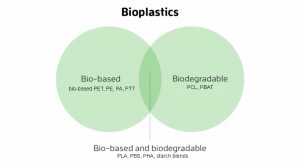Biodegradable – Compostable – OXO-degradable plastics.
Nearly every material will biodegrade, given enough time. But the length of the biodegradation process is highly dependent on environmental conditions including oxygen levels, humidity and temperature, and on the mechanical impacts – mixing, vibration.
So just claiming that a plastic is “biodegradable” without stating conditons and time frame is totally misleading to consumers.
Bioplastics: Bio-based vs.Biodegradable
Bioplastics refer to a large family of plastics which are either:
- sourced from biomass at the beginning of their life (bio-based),
- metabolized into organic biomass at the end of their life (biodegradable), or
- both sourced from biomass and broken down into biomass.

Based on this, bioplastics can be broken down into three classifications:
- Non-biodegradable and fully or partially bio-based ( bio-based PET, PE, PA, PTT )
- Biodegradable and petroleum-based ( PCL, PBAT ).
- Biodegradable and fully or partially bio-based (e.g., PLA, PBS, PHA, starch blends )
- ( and excluding non-degradable fossil fuel based plastics – PET, PP, PE )

Biodegradable plastics are a relatively small subset of bioplastics which can be converted into water, carbon dioxide (CO2) and bio-mass over time with the help of micro-organisms – this process is called biodegradation. And because the biodegradability of a plastic lies with the chemical properties of the polymer – and not the source of the feedstock – biodegradable plastics can be either bio- or petroleum-based.
Compostable plastics are a subset of biodegradable plastics, defined by the standard conditions and timeframe under which they will biodegrade. All compostable plastics are biodegradable, but not all biodegradable plastics would be considered compostable.

Certified compostable: A more specific claim of biodegradability to international standards for biodegradation in an industrial composting facility environment.
( eg: “…will disintegrate within 12 weeks and biodegrade at least 90% within 180 days in a municipal or industrial composting facility. Approximately 10% of solid material will be left at six months in the form of biomass and water, and be free of toxins.”)
A very limited subset is Home Compostable – the lower temparatures mean only very thin PLA or starch blends layered items can biodegrade in any reasonable time frame. So home composting is confined to paper and food waste.
OXO-degradable plastics (aka Micro-plastics )
Oxo-degradables are neither a bioplastic nor a biodegradable plastic – but are conventional plastic mixed with an additive in order to imitate biodegredation.
Oxo-degradable plastics quickly fragment into smaller and smaller pieces – micro-plastics, and don’t break down at the molecular or polymer level. These micro-plastics are left in the environment for many hundreds of years.
Bio-based PLA
Polyacitic Acid is a condensation of lactic acid. It will compost in commercial situations, ( but takes 100 years in undisturbed landfill ) and if in very thin layers, in home composts.
It is a thermoplastic and can be mechanically recycled with no loss of function or properties – but it is type #7 and can not be mixed with recycle plastic type #1 – #6. It is food safe and even gets used in making medical implements and parts, as it dissolves in the body over time.
Tom Danby, Moonee Valley Sustainability, 2020

